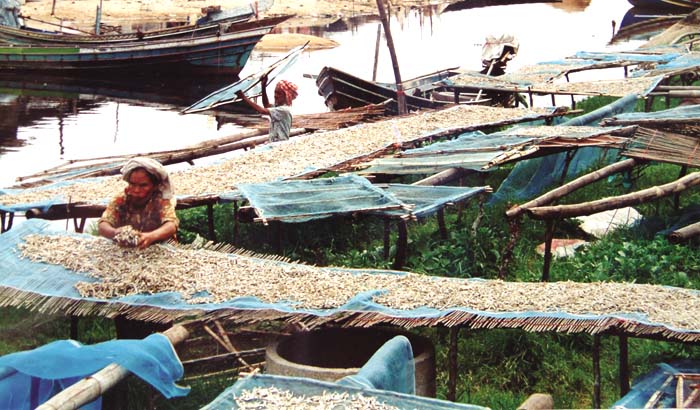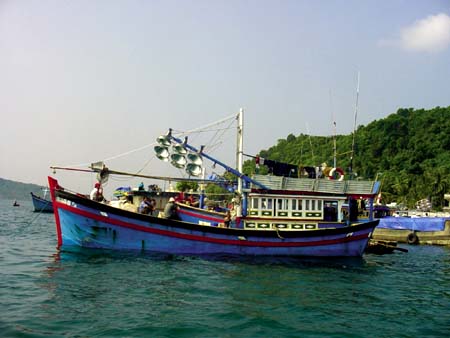
Simon Funge-Smith, FAO
Simple processing of small low value fish drying on racks. These are often staple foods for coastal communities when caught from small scale vessels
Hanoi, Viet Nam, 7–9 June 2005
Simon Funge-Smith1
The Regional Workshop on Low Value and “Trash Fish”in the Asia-Pacific Region was held in Hanoi, Viet Nam, from 7 to 9 June 2005, in collaboration with regional partner organizations, namely the Australian Centre for International Agriculture Research (ACIAR), the Mekong River Commission (MRC), the Network of Aquaculture Centres in Asia-Pacific (NACA), Southeast Asian Fisheries Development Center (SEAFDEC), the WorldFish Center (WFC), and the Reversing Environmental Degradation in the South China Sea (UNEP/SCS).
The workshop reviewed the current trends and status of “trash”fish production and their utilization in the Asia Pacific region and discussed a variety of issues relating to “trash fish”. Based on this background information, the workshop developed strategies to address the identified issues and designed action oriented outputs to implement the strategies, at national, sub-regional and regional levels. These outputs will be fed through to the Asia-Pacific Fishery Commission (APFIC) Session in 2006 for action.
The Asia-Pacific region dominates many aspects of world fishery production. In 2002, total production was in the magnitude of 133 million tonnes, where Asia-Pacific countries were responsible for 50 percent of capture fishery production and 89 percent of aquaculture production. The reliance of the region on fishing as a means of creating employment and providing export earnings and food security is apparent. Throughout the region, captured and cultured marine fisheries continue to play an important role in the food security, poverty alleviation and economies of many countries. Marine fisheries resources have been largely overexploited and, as a result, development of coastal aquaculture has been encouraged to provide the protein, income, employment and export earnings for some countries. Such a policy trend implies, however, that sufficient food for aquaculture production will be available. Inevitably, a dangerous spiral has evolved where the demand for low value/trash fish has supported increased fishing pressure on already degraded resources. This raises some important questions regarding the social, economic and ecological costs and benefits of the system, its sustainability and future trends.
The marine capture fishery sector is dominated by small-scale, labour intensive vessel operations that use multiple gears to catch an extremely diverse species composition. Local markets and processing techniques are specialised and are generally geared towards the needs of the local community. Fisher folk are often considered to be among the poorest of the poor and the small fishing communities are highly dependent on fishing for their survival. This pressure seemingly fuels overexploitation and ecosystem degradation. The lack of appropriate management measures as well as conflicting short-term goals of production growth by national administrations provide further challenges to the development of sustainable fisheries in the region. The increasing importance of low value/trash fish is very influential in this regard. Low value/trash fish can be defined in many ways and important regional differences exist. For the purpose of the regional workshop, low value/trash fish is defined as: “Fish that have a low commercial value by virtue of their low quality, small size or low consumer preference. They are either used for human consumption (often processed or preserved) or used for livestock/fish, either directly or through reduction to fish meal/oil”. There is, in general, a lack of accurate information on how much low value/trash fish use is present in Asia-Pacific, but a conservative estimate is that 25 percent of the total marine capture is destined for livestock and aquaculture feed, based on the best available evidence. The uses of low value/trash fish are diverse and include:
Several issues concerning the production and use of low value/trash fish need to be resolved in order to ensure that fisheries in Asia-Pacific contribute to the region's sustainable development. These include:
It is the continued expansion of aquaculture and its dependency on capture fisheries for low value/trash fish that is the main driver of the discussions during the workshop. The expansion is in response to stagnating marine catches worldwide, and the continued need for fish supply, employment creation and export earnings. The use of low value/trash fish as direct feed or fish meal for aquaculture is economically viable, and the increasing low value/trash fish prices reflect the fact that their supply is unable to meet the demand for fish feed. There is a general concern that the rapid expansion of aquaculture may ultimately be constrained by the dependence on low value/trash fish and fish meal, popularly referred to as the “fish meal trap”. Further, if one accepts that supplies of low value/trash fish are limited and that prices are increasing, Asia-Pacific countries may need to increase imports of fish meal from the global market for the aquaculture industry, or replace them with other feed materials. The replacement of fish meal in aquaculture diets is, hence, a major international research priority. There is also an increasing conflict between the use of low value/trash fish for feed and human consumption. It has been argued that it would be more efficient and ethical to divert more of the limited supply to human food, using value-added products. Proponents of this suggest that using low value/trash fish as food for domestic consumers is more appropriate than supplying fish meal plants for an export, income oriented aquaculture industry, producing high-value commodities. On the other hand, food security can also be increased by improving the income generation abilities of poor people, and it can be argued that the large volume of people employed in both fishing and aquaculture has a beneficial effect. The money made from low value/trash fishing is now also a main reason why many vessels continue to be economically viable and remain in fisheries. However, the increased exploitation levels of fish lower down the food chain could be important in the longer term. In fact, there is currently a lack of scientific evidence to inform fisheries managers of how sustainable the ecosystem is, and more research is needed in this regard. From a socio-economic perspective, the gains from current fishing practices are clear, but perhaps more information should also be gathered on who the main beneficiaries are, and how a change in the fishery/aquaculture relationship would impact the community and its dependents.
The role of poor handling and post-harvest in small-scale fisheries continues to play a role in the supply of low value/trash fish. Even if it were possible for fishers to adopt better practices to land a better catch, the benefits of doing so are probably outweighed by the costs of capital investments. Indeed, if prices of low value/trash fish remain high then the incentives to land better quality fish for human consumption will not be strong. The same can be argued for growth overfishing that will likely need an overall reduction of fishing effort by the fleet (at a social cost) to allow juveniles to grow to a larger size before being harvested. One positive outcome of the current low value/trash fishing practice, however, is that, given the high level of utilisation of catches, the problem of discarding unwanted catch is rather negligible.
One obvious but important conclusion is the strong inter-dependency between capture fisheries and aquaculture, which will require more coordinated management in the future. There is still an urgent need to understand the overall system better and, although we now have an initial understanding and quantitative data to start addressing the management issues, we now need to urge the research community to take up the challenge.
Background papers presented at
the workshop can be downloaded from the APFIC website: http://www.apfic.org/modules/xfsection/article.php?articleid=1 while
the report of the meeting can be found at: http://www.apfic.org/modules/mydownloads/visit.php?cid=5&lid=130
http://www.apfic.org/modules/mydownloads/visit.php?cid=5&lid=131

Simon Funge-Smith, FAO
Light attracting anchovy fishing boats high quality fish is made into fish sauce and lower quality catch is directed into aquaculture